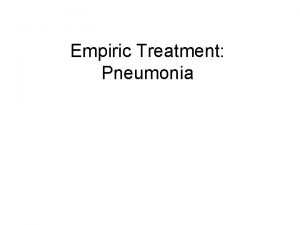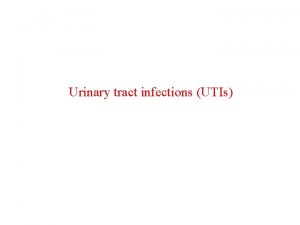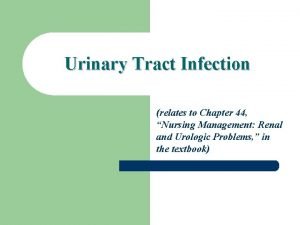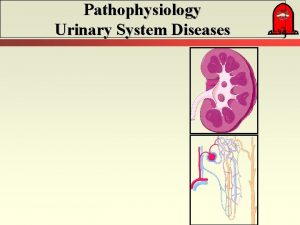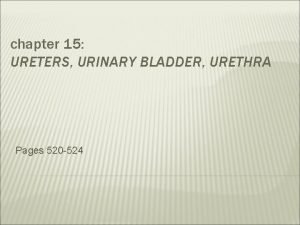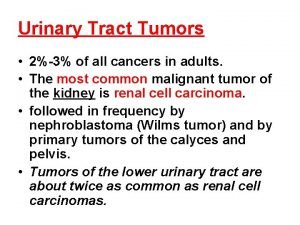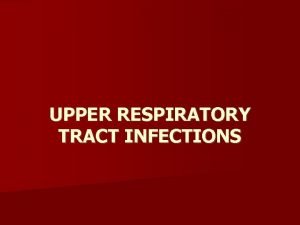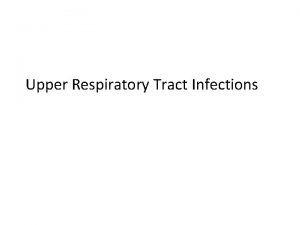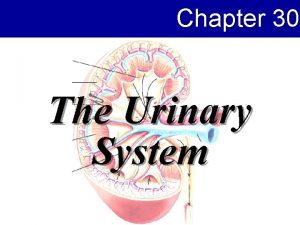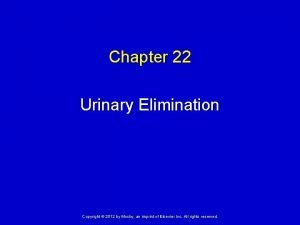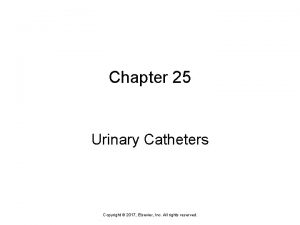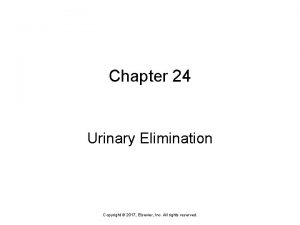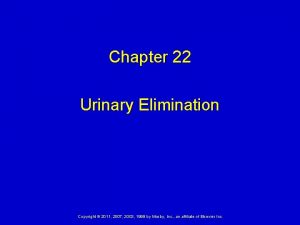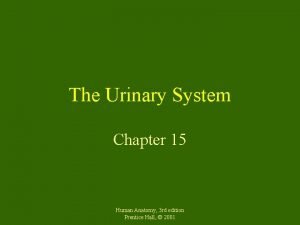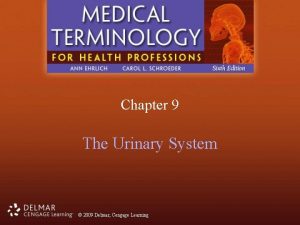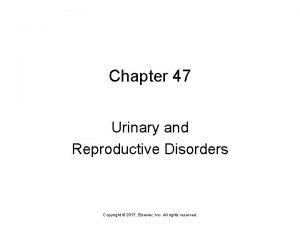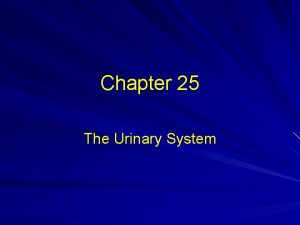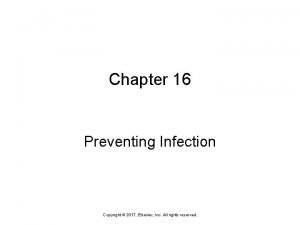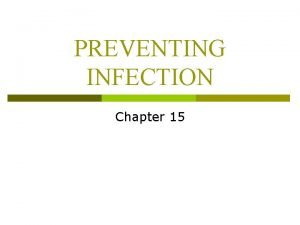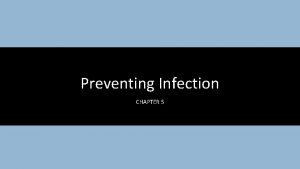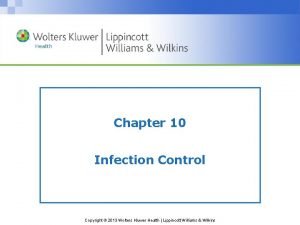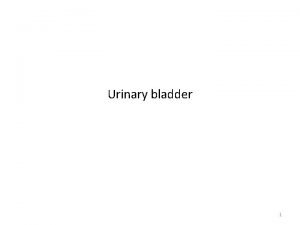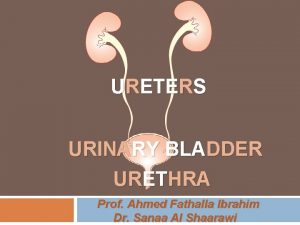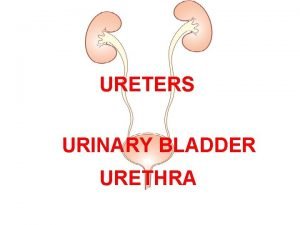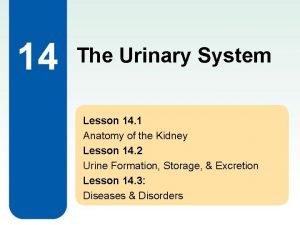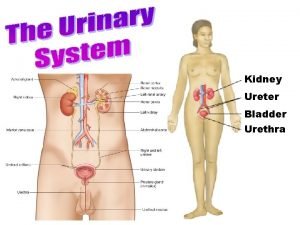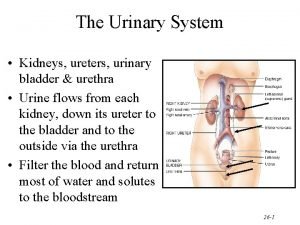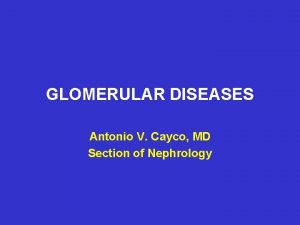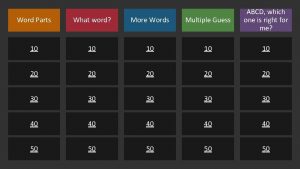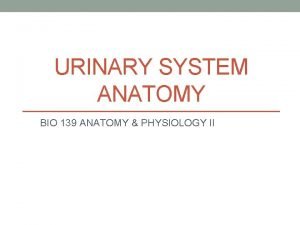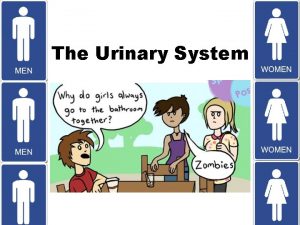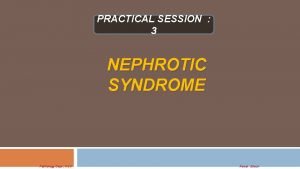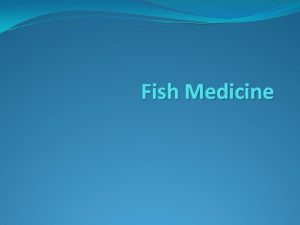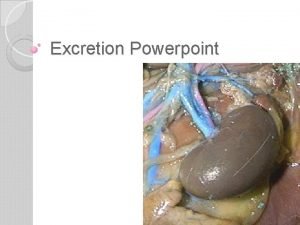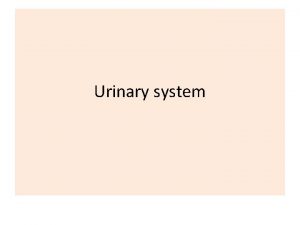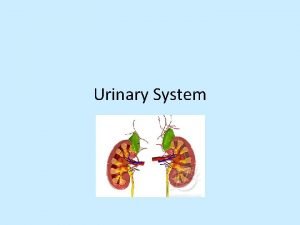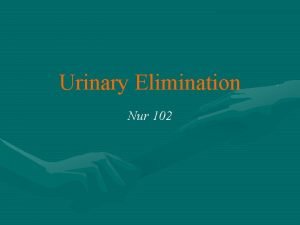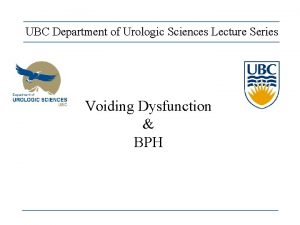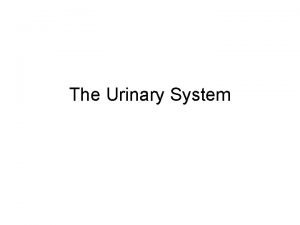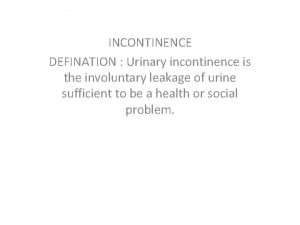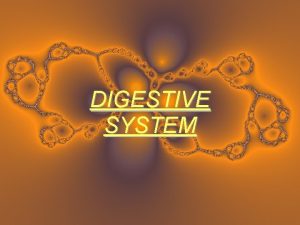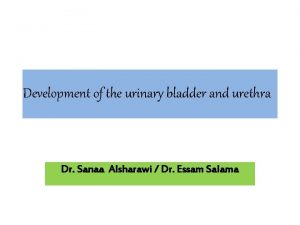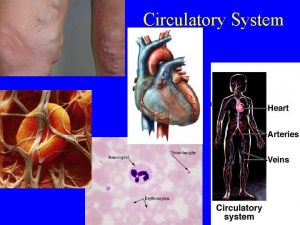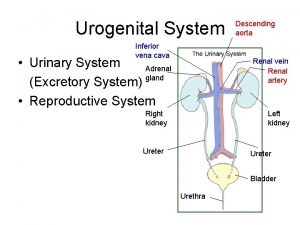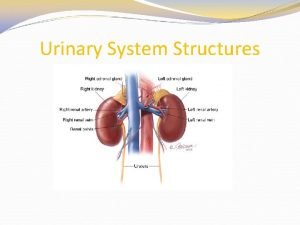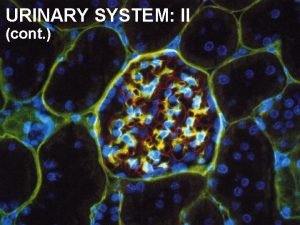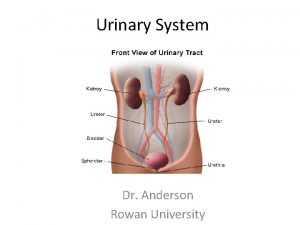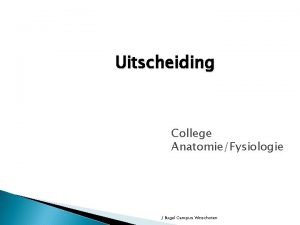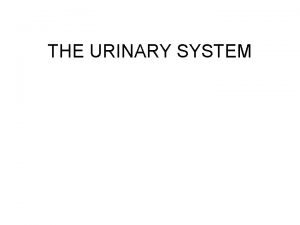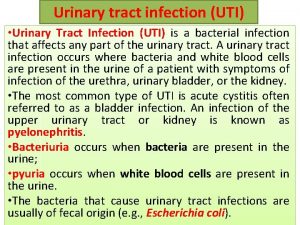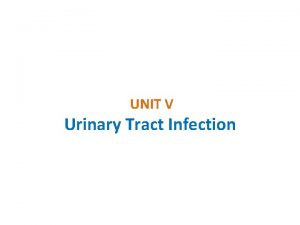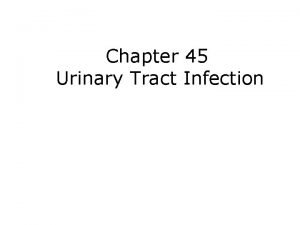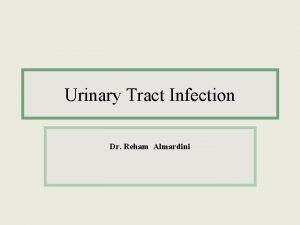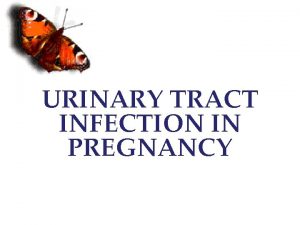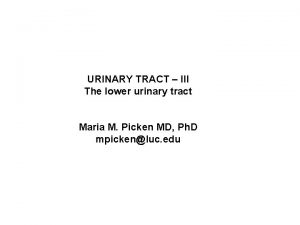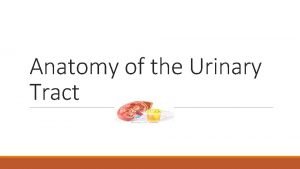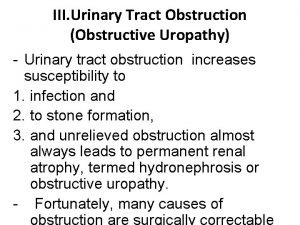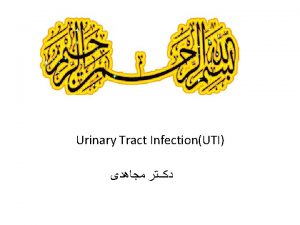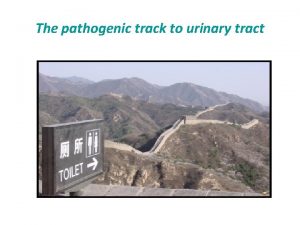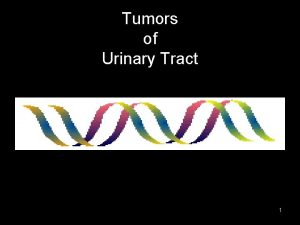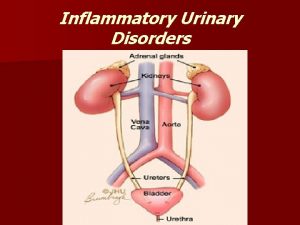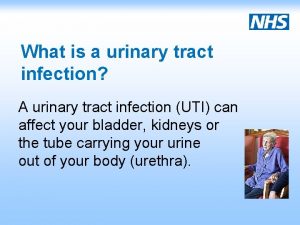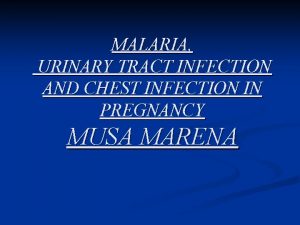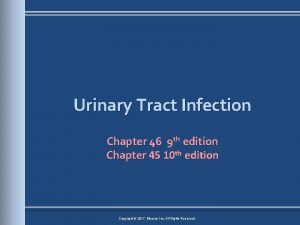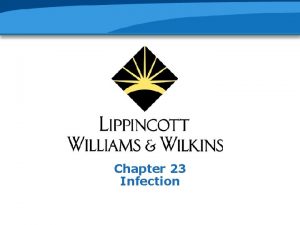Urinary Tract Infection Chapter 46 9 th edition
















































































- Slides: 80

Urinary Tract Infection Chapter 46 9 th edition Chapter 45 10 th edition Copyright © 2017, Elsevier Inc. All Rights Reserved.

Urinary Tract Infection (UTI) § Most common bacterial infection in women § May be caused by a variety of disorders § Bacterial infection most common Copyright © 2017, Elsevier Inc. All Rights Reserved.

Urinary Tract Infection § Bladder and its contents are free of bacteria in majority of healthy people § Minority of healthy individuals have some bacteria colonizing in bladder § Called asymptomatic bacteriuria and does not justify treatment Copyright © 2017, Elsevier Inc. All Rights Reserved.

Urinary Tract Infection § Escherichia coli (E. coli) most common pathogen § Counts of 105 CFU/m. L or more indicate significant UTI § Counts as low as 102 CFU/m. L in a person with signs/symptoms are indicative of UTI Copyright © 2017, Elsevier Inc. All Rights Reserved.

Urinary Tract Infection § Fungal and parasitic infections may cause UTIs § Patients at risk § Immunosuppressed § Diabetic § Have kidney problems § Have undergone multiple antibiotic courses § Have traveled to developing countries Copyright © 2017, Elsevier Inc. All Rights Reserved.

Classification of UTI § Upper versus lower § Upper urinary tract § Renal parenchyma, pelvis, and ureters § Typically causes fever, chills, flank pain § Example § Pyelonephritis: inflammation of renal parenchyma and collecting system Copyright © 2017, Elsevier Inc. All Rights Reserved.

Classification of UTI § Upper versus lower § Lower urinary tract § Usually no systemic manifestations § Examples § Cystitis: inflammation of bladder § Urethritis: inflammation of urethra Copyright © 2017, Elsevier Inc. All Rights Reserved.

Classification of UTI § Urosepsis § UTI that has spread systemically § Life-threatening condition requiring emergent treatment Copyright © 2017, Elsevier Inc. All Rights Reserved.

Classification of UTI Copyright © 2017, Elsevier Inc. All Rights Reserved.

Classification of UTI § Complicated versus uncomplicated § Uncomplicated UTI § Occurs in otherwise normal urinary tract § Usually only involves bladder Copyright © 2017, Elsevier Inc. All Rights Reserved.

Classification of UTI § Complicated versus uncomplicated § Complicated UTI § Coexists with presence of § Obstruction or stones § Catheters § Abnormal GU tract § Diabetes/neurologic disease § Resistance to antibiotics § immunocompromised § Pregnancy-induced changes § Recurrent infection Copyright © 2017, Elsevier Inc. All Rights Reserved.

Etiology and Pathophysiology § Urinary tract above urethra normally sterile § Defense mechanisms exist to maintain sterility/prevent UTIs § Complete emptying of bladder § Ureterovesical junction competence § Ureteral peristaltic activity Copyright © 2017, Elsevier Inc. All Rights Reserved.

Etiology and Pathophysiology § Defense mechanisms § Acidic p. H (less than 6. 0) § High urea concentration § Abundant glycoproteins Copyright © 2017, Elsevier Inc. All Rights Reserved.

Etiology and Pathophysiology § Alteration of defense mechanisms increases risk of contracting UTI § Predisposing factors § Factors increasing urinary stasis § Examples: BPH, tumor, neurogenic bladder § Foreign bodies § Examples: catheters, calculi, instrumentation Copyright © 2017, Elsevier Inc. All Rights Reserved.

Etiology and Pathophysiology § Predisposing factors § Anatomic factors § Examples: obesity, congenital defects, fistula § Compromising immune response factors § Examples: age, HIV, diabetes Copyright © 2017, Elsevier Inc. All Rights Reserved.

Etiology and Pathophysiology § Predisposing factors § Functional disorders § Example: constipation § Other factors § Examples: pregnancy, multiple sex partners (women) Copyright © 2017, Elsevier Inc. All Rights Reserved.

Etiology and Pathophysiology § Organisms introduced via ascending route from urethra and originate in the perineum § Less common routes § Bloodstream § Lymphatic system Copyright © 2017, Elsevier Inc. All Rights Reserved.

Etiology and Pathophysiology § Gram-negative bacilli normally found in GI tract: common cause § Urologic instrumentation allows bacteria to enter urethra and bladder Copyright © 2017, Elsevier Inc. All Rights Reserved.

Etiology and Pathophysiology § Contributing factor: urologic instrumentation § Allows bacteria present in opening of urethra to enter urethra or bladder § Sexual intercourse promotes “milking” of bacteria from perineum and vagina § May cause minor urethral trauma Copyright © 2017, Elsevier Inc. All Rights Reserved.

Etiology and Pathophysiology § Rarely results via hematogenous route § Kidney infection occurring from hematogenous transmission always preceded by injury to urinary tract § Obstruction of ureter § Damage from stones § Renal scars Copyright © 2017, Elsevier Inc. All Rights Reserved.

Etiology and Pathophysiology § Catheter-associated urinary tract infections (CAUTI) are the most common HAI § Causes § Often: E. coli § Less frequently: Pseudomonas species § Most are underrecognized and undertreated Copyright © 2017, Elsevier Inc. All Rights Reserved.

Clinical manifestations § Range from painful urination in uncomplicated urethritis or cystitis § To severe systemic illness associated with abdominal or back pain, fever, sepsis, and decreased kidney function in some cases of pyelonephritis Copyright © 2017, Elsevier Inc. All Rights Reserved.

Clinical Manifestations § Symptoms related to either bladder storage or bladder emptying § Bladder storage § Urinary frequency § Abnormally frequent (more often than every 2 hours) § Urgency § Sudden strong desire to void immediately § Incontinence § Loss or leakage or urine Copyright © 2017, Elsevier Inc. All Rights Reserved.

Clinical Manifestations § Bladder storage § Nocturia § Waking up two or more times at night to void § Nocturnal enuresis § Loss of urine during sleep § Bladder emptying § Weak stream § Hesitancy § Difficulty starting the urine stream Copyright © 2017, Elsevier Inc. All Rights Reserved.

Clinical Manifestations § Bladder emptying § Intermittency § Interruption of urinary stream during voiding § Postvoid dribbling § Urine loss after completion of voiding § Urinary retention § Inability to empty urine from bladder § Dysuria § Difficulty voiding Copyright © 2017, Elsevier Inc. All Rights Reserved.

Clinical Manifestations § Flank pain, chills, and fever indicate infection of upper tract § Pyelonephritis Copyright © 2017, Elsevier Inc. All Rights Reserved.

Clinical Manifestations § In older adults § Symptoms often absent § Nonlocalized abdominal discomfort rather than dysuria § Cognitive impairment possible § Fever less likely Copyright © 2017, Elsevier Inc. All Rights Reserved.

Diagnostic Studies § History and physical examination § Dipstick urinalysis § Identify presence of nitrites, WBCs, and leukocyte esterase § Urine culture Copyright © 2017, Elsevier Inc. All Rights Reserved.

Diagnostic Studies § Urine for culture and sensitivity (if indicated) § Clean-catch sample preferred § Specimen by catheterization or suprapubic needle aspiration more accurate § Determine bacteria susceptibility to antibiotics Copyright © 2017, Elsevier Inc. All Rights Reserved.

Diagnostic Studies § Imaging studies § Ultrasound § CT scan (CT urogram) Copyright © 2017, Elsevier Inc. All Rights Reserved.

Interprofessional Care Drug Therapy § Antibiotics § Selected on empiric therapy or results of sensitivity testing § Uncomplicated cystitis § Short-term course (typically 3 days) § Complicated UTIs § Long-term treatment (7 to 14 days or more) Copyright © 2017, Elsevier Inc. All Rights Reserved.

Interprofessional Care Drug Therapy § Antibiotics § Trimethoprim/sulfamethoxazole § Used to treat uncomplicated or initial UTI § Inexpensive § Taken twice a day Copyright © 2017, Elsevier Inc. All Rights Reserved.

Interprofessional Care Drug Therapy § Antibiotics § Nitrofurantoin (Macrodantin) § Given three or four times a day § Long-acting preparation (Macrobid) is taken twice daily § Ampicillin, amoxicillin, cephalosporins § Treat uncomplicated UTI Copyright © 2017, Elsevier Inc. All Rights Reserved.

Interprofessional Care Drug Therapy § Antibiotics § Fluoroquinolones § Treat complicated UTIs § Example: ciprofloxacin (Cipro) § Antifungals § Amphotericin or fluconazole § UTIs secondary to fungi Copyright © 2017, Elsevier Inc. All Rights Reserved.

Interprofessional Care Drug Therapy § Urinary analgesic § Phenazopyridine § Used in combination with antibiotics § Provides soothing effect on urinary tract mucosa § Stains urine reddish orange § Can be mistaken for blood and may stain underclothing Copyright © 2017, Elsevier Inc. All Rights Reserved.

Interprofessional Care Drug Therapy § Prophylactic or suppressive antibiotics sometimes administered to patients with repeated UTIs Copyright © 2017, Elsevier Inc. All Rights Reserved.

Nursing Management Nursing Assessment § Health history § Previous UTIs, calculi, stasis, retention, pregnancy, STIs, bladder cancer § Antibiotics, anticholinergics, antispasmodics § Urologic instrumentation § Urinary hygiene Copyright © 2017, Elsevier Inc. All Rights Reserved.

Nursing Management Nursing Assessment § Health History § Nausea, vomiting, anorexia, chills, nocturia, frequency, urgency § Suprapubic/lower back pain, bladder spasms, dysuria, burning sensation on urination Copyright © 2017, Elsevier Inc. All Rights Reserved.

Nursing Management Nursing Assessment § Objective Data § Fever § Hematuria, foul-smelling urine, tender, enlarged kidney § Leukocytosis, positive findings for bacteria, WBCs, RBCs, pyuria, ultrasound, CT scan, IVP Copyright © 2017, Elsevier Inc. All Rights Reserved.

Nursing Management Nursing Diagnoses § Impaired urinary elimination § Readiness for enhanced health management Copyright © 2017, Elsevier Inc. All Rights Reserved.

Nursing Management Planning § Patient will have § Relief from lower urinary tract symptoms (LUTS) § No upper urinary tract involvement § No recurrence Copyright © 2017, Elsevier Inc. All Rights Reserved.

Nursing Management Nursing Implementation § Health Promotion § Recognize individuals at risk § Debilitated persons § Older adults § Underlying diseases (HIV, diabetes) § Taking immunosuppressive drug or corticosteroids Copyright © 2017, Elsevier Inc. All Rights Reserved.

Nursing Management Nursing Implementation § Health Promotion § Emptying bladder regularly and completely § Evacuating bowel regularly § Wiping perineal area front to back § Drinking adequate fluids (person’s weight in pounds/2) § 20% of fluid comes from food Copyright © 2017, Elsevier Inc. All Rights Reserved.

Nursing Management Nursing Implementation § Health Promotion § Cranberry juice or cranberry tablets may reduce number of UTIs § Avoid unnecessary catheterization and early removal of indwelling catheters § Aseptic technique must be followed during instrumentation procedures Copyright © 2017, Elsevier Inc. All Rights Reserved.

Nursing Management Nursing Implementation § Health Promotion § Routine and thorough perineal care for all hospitalized patients § Answer call lights and offer bedpan or urinal at frequent intervals Copyright © 2017, Elsevier Inc. All Rights Reserved.

Prevention of CAUTI § Avoidance of unnecessary catheterization § Early removal of indwelling catheters Copyright © 2017, Elsevier Inc. All Rights Reserved.

Prevention of CAUTI § Follow aseptic technique for procedures § Handwashing before and after patient contact § Wear gloves for care of urinary catheters Copyright © 2017, Elsevier Inc. All Rights Reserved.

Nursing Management Nursing Implementation § Acute Care § Adequate fluid intake § Patient may think condition will worsen because of discomfort § Dilutes urine, making bladder less irritable § Flushes out bacteria before they can colonize Copyright © 2017, Elsevier Inc. All Rights Reserved.

Nursing Management Nursing Implementation § Acute Care § Avoid caffeine, alcohol, citrus juices, chocolate, and highly spiced foods § Potential bladder irritants Copyright © 2017, Elsevier Inc. All Rights Reserved.

Nursing Management Nursing Implementation § Acute Care § Application of local heat to suprapubic or lower back may relieve discomfort § Instruct patient about drug therapy and side effects Copyright © 2017, Elsevier Inc. All Rights Reserved.

Nursing Management Nursing Implementation § Acute Care § Emphasize taking full course of antibiotics despite disappearance of symptoms § Second or reduced dosage of a drug may be ordered after initial course in susceptible patients Copyright © 2017, Elsevier Inc. All Rights Reserved.

Nursing Management Nursing Implementation § Acute Care § Instruct patient to monitor for signs of improvement and decrease in or cessation of symptoms § Teach patient to promptly report to HCP § Persistence of LUTS beyond antibiotic treatment course § Onset of flank pain § Fever Copyright © 2017, Elsevier Inc. All Rights Reserved.

Nursing Management Nursing Implementation § Ambulatory Care § Emphasize importance of compliance with drug regimen § Take as ordered § Maintain adequate fluids § Regular voiding (every 3 to 4 hours) § Void after intercourse Copyright © 2017, Elsevier Inc. All Rights Reserved.

Nursing Management Nursing Implementation § Ambulatory Care § Temporarily discontinue use of contraceptive diaphragm § Instruct on follow-up care § Recurrence of symptoms: typically 1 to 2 weeks after therapy Copyright © 2017, Elsevier Inc. All Rights Reserved.

Nursing Management Evaluation § The patient with a UTI will § Experience normal urinary elimination patterns § Report relief of bothersome urinary tract symptoms § Verbalize knowledge of treatment regimen Copyright © 2017, Elsevier Inc. All Rights Reserved.

Acute Pyelonephritis Copyright © 2017, Elsevier Inc. All Rights Reserved.

Etiology and Pathophysiology § Inflammation of renal parenchyma and collecting system (including the renal pelvis) § Most common cause is bacterial infection § Fungi, protozoa, or viruses can also infect kidneys Copyright © 2017, Elsevier Inc. All Rights Reserved.

Acute Pyelonephritis Copyright © 2017, Elsevier Inc. All Rights Reserved.

Copyright © 2017, Elsevier Inc. All Rights Reserved.

Etiology and Pathophysiology § Urosepsis § Systemic infection from urologic source § Prompt diagnosis/treatment critical § Can lead to septic shock and death unless promptly treated Copyright © 2017, Elsevier Inc. All Rights Reserved.

Etiology and Pathophysiology § Usually begins with colonization and infection of lower tract via ascending urethral route § Frequent causes § Escherichia coli § Proteus § Klebsiella § Enterobacter Copyright © 2017, Elsevier Inc. All Rights Reserved.

Etiology and Pathophysiology § Preexisting factor usually present § Vesicoureteral reflux § Retrograde (backward) movement of urine from lower to upper urinary tract § Dysfunction of lower urinary tract § Obstruction from BPH § Stricture § Urinary stone § CAUTI Copyright © 2017, Elsevier Inc. All Rights Reserved.

Etiology and Pathophysiology § Commonly starts in renal medulla and spreads to adjacent cortex § Recurring episodes lead to scarred, poorly functioning kidney and chronic pyelonephritis Copyright © 2017, Elsevier Inc. All Rights Reserved.

Clinical Manifestations § Mild fatigue § Chills § Fever § Vomiting § Malaise § Flank pain Copyright © 2017, Elsevier Inc. All Rights Reserved.

Clinical Manifestations § LUTS characteristic of cystitis § Dysuria, urgency, frequency § Costovertebral tenderness to percussion typically present on affected side § Manifestations may subside in a few days, even without therapy § Bacteriuria and pyuria still persist Copyright © 2017, Elsevier Inc. All Rights Reserved.

Diagnostic Studies § History § Physical examination § Palpation for CVA pain § Laboratory tests § Urinalysis § Urine for culture and sensitivity § CBC with WBC differential § Blood culture (if bacteremia is suspected) Copyright © 2017, Elsevier Inc. All Rights Reserved.

Diagnostic Studies § Ultrasound § CT urogram Copyright © 2017, Elsevier Inc. All Rights Reserved.

Interprofessional Care § Hospitalization for patients with severe infections and complications § Such as nausea and vomiting with dehydration § Signs/symptoms typically improve within 48 to 72 hours after therapy starts Copyright © 2017, Elsevier Inc. All Rights Reserved.

Interprofessional Care § Drug therapy § Antibiotics § Parenteral administration in hospital to rapidly establish high drug levels § NSAIDs or antipyretic drugs § Fever § Discomfort § Urinary analgesics Copyright © 2017, Elsevier Inc. All Rights Reserved.

Interprofessional Care § Relapses may be treated with 6 week course of antibiotics Antibiotic prophylaxis may be used for recurrent infection § Follow-up urine culture and imaging studies § Copyright © 2017, Elsevier Inc. All Rights Reserved.

Interprofessional Care § Urosepsis is characterized by bacteriuria and bacteremia § Close observation and vital sign monitoring are essential § Prompt recognition and treatment of septic shock may prevent irreversible damage or death Copyright © 2017, Elsevier Inc. All Rights Reserved.

Nursing Management Nursing Assessment § Health History § Previous UTIs, calculi, stasis, retention, pregnancy, STIs, bladder cancer § Antibiotics, anticholinergics, antispasmodics § Urologic instrumentation § Urinary hygiene Copyright © 2017, Elsevier Inc. All Rights Reserved.

Nursing Management Nursing Assessment § Health History § Nausea, vomiting, anorexia, chills, nocturia, frequency, urgency § Suprapubic or lower back pain, bladder spasms, dysuria, burning sensation on urination Copyright © 2017, Elsevier Inc. All Rights Reserved.

Nursing Management Nursing Assessment § Objective Data § Fever § Hematuria, foul-smelling urine, tender, enlarged kidney § Leukocytosis; positive findings for bacteria, WBCs, RBCs; pyuria; ultrasound, CT scan, and IVP abnormalities Copyright © 2017, Elsevier Inc. All Rights Reserved.

Nursing Management Nursing Diagnoses § Acute pain § Impaired urinary elimination Copyright © 2017, Elsevier Inc. All Rights Reserved.

Nursing Management Planning § Patient will have § Normal renal function § Normal body temperature § No complications § Relief of pain § No recurrence of symptoms Copyright © 2017, Elsevier Inc. All Rights Reserved.

Nursing Management Nursing Implementation § Health Promotion § Early treatment for cystitis to prevent ascending infections § Patients with structural abnormalities are at high risk § Stress need for regular medical care Copyright © 2017, Elsevier Inc. All Rights Reserved.

Nursing Management Nursing Implementation § Ambulatory Care § Continue medications as prescribed § Follow-up urine culture § Recognize manifestations of recurrence or relapse § Encourage adequate fluids Copyright © 2017, Elsevier Inc. All Rights Reserved.

Nursing Management Nursing Implementation § Ambulatory Care § Rest to increase comfort § Long-term, low-dose antibiotics to prevent relapses or reinfections § Explain rationale to increase adherence Copyright © 2017, Elsevier Inc. All Rights Reserved.

Nursing Management Evaluation § Use of nonanalgesic relief measures § Appropriate use of analgesics § Pass urine without urgency § Urine free of blood § Adequate intake of fluids Copyright © 2017, Elsevier Inc. All Rights Reserved.
 ç
ç Complicated urinary tract infection
Complicated urinary tract infection Urinary tract infection in pregnancy ppt
Urinary tract infection in pregnancy ppt Nursing management for urinary tract infection
Nursing management for urinary tract infection Symptoms of urinary tract infection
Symptoms of urinary tract infection Urinary tract obstruction
Urinary tract obstruction Urethra
Urethra Tumor in the urinary tract
Tumor in the urinary tract Classification of upper respiratory tract infection
Classification of upper respiratory tract infection Lrti
Lrti Sexually transmitted diseases
Sexually transmitted diseases Pyramidal vs extrapyramidal
Pyramidal vs extrapyramidal Dorsal reticulospinal tract
Dorsal reticulospinal tract Figure 15-3 the urinary system
Figure 15-3 the urinary system Urethr/o medical terminology
Urethr/o medical terminology Chapter 30 the urinary system workbook answers
Chapter 30 the urinary system workbook answers Chapter 22 urinary elimination
Chapter 22 urinary elimination Kidney pyramid labeled
Kidney pyramid labeled Chapter 25 urinary catheters
Chapter 25 urinary catheters Chapter 24 urinary elimination
Chapter 24 urinary elimination Chapter 22 urinary elimination
Chapter 22 urinary elimination Chapter 20 urinary/excretory system
Chapter 20 urinary/excretory system The urinary system chapter 15
The urinary system chapter 15 Chapter 9 the urinary system labeling exercises
Chapter 9 the urinary system labeling exercises Chapter 47 urinary and reproductive disorders
Chapter 47 urinary and reproductive disorders The urinary system consists of
The urinary system consists of Using mis 10th edition
Using mis 10th edition Using mis 10th edition
Using mis 10th edition Chapter 19 disease transmission and infection prevention
Chapter 19 disease transmission and infection prevention Chapter 19 disease transmission and infection prevention
Chapter 19 disease transmission and infection prevention Chapter 16 preventing infection
Chapter 16 preventing infection Chapter 16 infection prevention and control
Chapter 16 infection prevention and control Chapter 16 infection control and standard precautions
Chapter 16 infection control and standard precautions Chapter 15:9 maintaining transmission based precautions
Chapter 15:9 maintaining transmission based precautions Chapter 15:4 observing standard precautions
Chapter 15:4 observing standard precautions Chapter 19 disease transmission and infection prevention
Chapter 19 disease transmission and infection prevention Chapter 15 preventing infection
Chapter 15 preventing infection Define infection prevention chapter 5
Define infection prevention chapter 5 Chapter 10 infection control
Chapter 10 infection control Urinary system introduction
Urinary system introduction Urinary bladder apex and base
Urinary bladder apex and base Superior surface of urinary bladder
Superior surface of urinary bladder Ureteral blood supply
Ureteral blood supply Suprolateral
Suprolateral Urinary system interesting facts
Urinary system interesting facts Cvc care bundle checklist
Cvc care bundle checklist Urogenital papilla fetal pig
Urogenital papilla fetal pig Lesson 14.2 male and female urinary structures
Lesson 14.2 male and female urinary structures What is the function of the bladder
What is the function of the bladder Nephron urinary system
Nephron urinary system Sustentocyte
Sustentocyte Urinary
Urinary _____ is difficulty in starting a urinary stream.
_____ is difficulty in starting a urinary stream. Urinary system model
Urinary system model Urinary system fun fact
Urinary system fun fact Carcinoma
Carcinoma Optic lobes
Optic lobes Urinary system powerpoint
Urinary system powerpoint Parietal layer of bowman's capsule
Parietal layer of bowman's capsule Functions of adh
Functions of adh Impaired urinary elimination
Impaired urinary elimination Urinary retention
Urinary retention Urine contains
Urine contains Figure 15-3 is a diagram of the nephron
Figure 15-3 is a diagram of the nephron L
L Stretch receptors in urinary bladder
Stretch receptors in urinary bladder Defination of urinary system
Defination of urinary system Homework
Homework Rat internal organs
Rat internal organs Frog spinal nerves
Frog spinal nerves Development of urinary bladder
Development of urinary bladder Urethra development
Urethra development Rat urinary system
Rat urinary system Vena cava excretory system
Vena cava excretory system Figure 15-4 is a diagram of a nephron
Figure 15-4 is a diagram of a nephron Parietal layer bowman's capsule
Parietal layer bowman's capsule Bowmans capsule
Bowmans capsule Classification of urinary antiseptics
Classification of urinary antiseptics Lymph tissue fluid
Lymph tissue fluid Urinary system
Urinary system Flow of urine diagram
Flow of urine diagram

